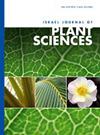从茜草中分离的多种内生假单胞菌lini菌株对植物生长的促进潜力。
IF 0.9
4区 生物学
Q4 PLANT SCIENCES
引用次数: 4
摘要
鹰嘴豆(Cicer arietinum)是印度主要的豆类作物之一,由于各种非生物和生物胁迫,其产量急剧下降。居住在鹰嘴豆根瘤和根部的内生细菌使寄主能够抵抗这些压力。从鹰嘴豆根瘤和根中分离到21株内生细菌,对其产氨、有机酸、铁载体、氰化氢(HCN)和植物激素吲哚乙酸(IAA)等多种植物生长促进性状进行了筛选。其中,86%的分离株产生氨,约50%的分离株产生有机酸、HCN和铁载体,29%的分离株产生ACC(1-氨基环丙烷-1-羧酸)脱氨酶,而只有14%的分离株能溶解磷酸盐。所有菌株均能产生11.6 ~ 85.2 μg/ml的IAA,其中CPJN 13菌株产生的IAA最大(85.5±2.33 μg/ml)。选择CPJN13进行IAA优化研究。优化条件下,IAA的得率提高了4倍,为331±4.96 μg/ml。通过薄层色谱和高效液相色谱分析证实了IAA的产生。CPJN13在鹰嘴豆苗上施用后,植株生长参数显著提高。CPJN13的16S rDNA测序结果显示其与lini假单胞菌具有相似性,已提交给NCBI,登录号为MF574502。据我们所知,这是第一次报道P. lini作为鹰嘴豆结节内生菌的存在。本研究结果表明,内生真菌对植物生长具有潜在的促进作用。本文章由计算机程序翻译,如有差异,请以英文原文为准。
Plant growth promoting potential of multifarious endophytic Pseudomonas lini strain isolated from Cicer arietinum L.
Chickpea (Cicer arietinum), one of the major pulse crops in India, endured extreme reduction in production due to various abiotic and biotic stresses. Endophytic bacteria residing in the nodules and roots of chickpea plants enable host in combating these stresses. Twenty one endophytic bacteria isolated from nodules and roots of chickpea were screened for multiple plant growth promoting traits like ammonia, organic acid, siderophore, hydrogen cyanide (HCN) and phytohormone indole acetic acid (IAA) production. Out of these, 86% isolates produced ammonia, around 50% isolates produced organic acid, HCN and siderophore, 29% isolates produced ACC (1-aminocyclopropane-1-carboxylic acid) deaminase, while only 14% isolates solubilized phosphate. Interestingly, all the isolates were able to produce IAA ranging from 11.6–85.2 μg/ml, isolate CPJN 13 being the maximum IAA producer (85.5±2.33 μg/ml). Isolate CPJN13 was selected for IAA optimization studies. The yield of IAA increased up to 4 fold i.e. 331±4.96 μg/ml at optimized conditions. IAA production was also confirmed by TLC and HPLC analysis of crude IAA extract. The application of CPJN13 on chickpea seedlings resulted in significant increase in plant growth parameters. The 16S rDNA sequencing of CPJN13 revealed its similarity with Pseudomonas lini strain and submitted to NCBI with accession number MF574502. To best of our knowledge, this is the first report of the presence of P. lini as endophyte in chickpea nodules. The results of this study imply that the endophytic P. lini has a potential role to enhance the plant growth.
求助全文
通过发布文献求助,成功后即可免费获取论文全文。
去求助
来源期刊

Israel Journal of Plant Sciences
生物-植物科学
CiteScore
1.90
自引率
0.00%
发文量
17
审稿时长
>12 weeks
期刊介绍:
The Israel Journal of Plant Sciences is an international journal of extensive scope that publishes special issues dealing with all aspects of plant sciences, including but not limited to: physiology, cell biology, development, botany, genetic
 求助内容:
求助内容: 应助结果提醒方式:
应助结果提醒方式:


